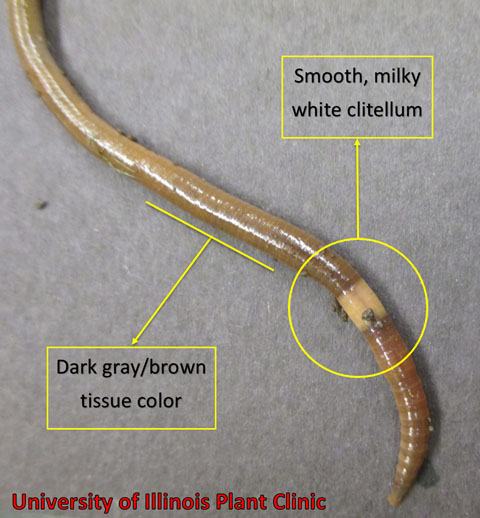Issue 10, June 27, 2016
Invasive Species Alert: Jumping Worm Confirmed in Southern Illinois

Jumping worm from Williamson County, IL. Photo credit: Chris Evans, University of Illinois Extension
A new invasive species, jumping worm (Amynthas spp.), was identified in Illinois in 2015. By the end of the year these worms had been confirmed in three northern counties: Cook, DuPage, and McHenry. A worm from far southern Illinois in Williamson County was examined at the University of Illinois Plant Clinic and confirmed as a jumping worm, drastically increasing the range of this worm in Illinois.
Jumping worms are earthworms native to East Asia. They have been sold in the United States as bait under the names crazy worm, Alabama jumper, and snake worm. The worm has characteristic coloration and behavior. When disturbed, jumping worms become very active, wriggling and thrashing vigorously. Adult worms are approximately the same size as our naturalized earthworms, but are much darker. Most of the tissue is dark gray/brown, with a milky white or light gray band of tissue (the clitellum) circling the body. The clitellum is smooth, compared to other common species in which the clitellum is raised compared to the body.

Jumping worms are voracious consumers of organic material, which can affect soil quality. They breed quickly and eggs survive Illinois winters. Adults reach maturity in approximately 60 days, allowing populations to double during the growing season. These worms are also capable of reproducing without mating. There are concerns about the effect these worms will have on native areas, ornamental plantings, and agronomic fields. The worms have been identified in several U.S. states, including Wisconsin (2013) and Indiana (2015). From reports from Wisconsin, it appears that these worms are most damaging in areas without other established earthworm populations.
Recommendations to prevent the spread of jumping worms and their eggs include cleaning equipment before moving to another site, reducing the transportation of mulch and soil, and carefully inspecting nursery plants before installing them in a new landscape.
The University of Illinois Plant Clinic, in cooperation with the Illinois Department of Agriculture, the Illinois Natural History Survey, and University of Illinois Extension, is trying to identify where these worms are in Illinois. If you suspect you have found a jumping worm, please send pictures or video of the worm's movement to the University of Illinois at plantclinic@illinois.edu. You can also contact us at 217-333-0519.
We have found that the worms are very sensitive to heat and cold and so far, no live samples have survived being sent via mail. Samples preserved in ethanol allow us to observe physical characteristics, but discoloration of the tissue occurs, complicating identification. Please contact us before sending a sample to the Plant Clinic. (Diane Plewa)
Author:
Diane Plewa